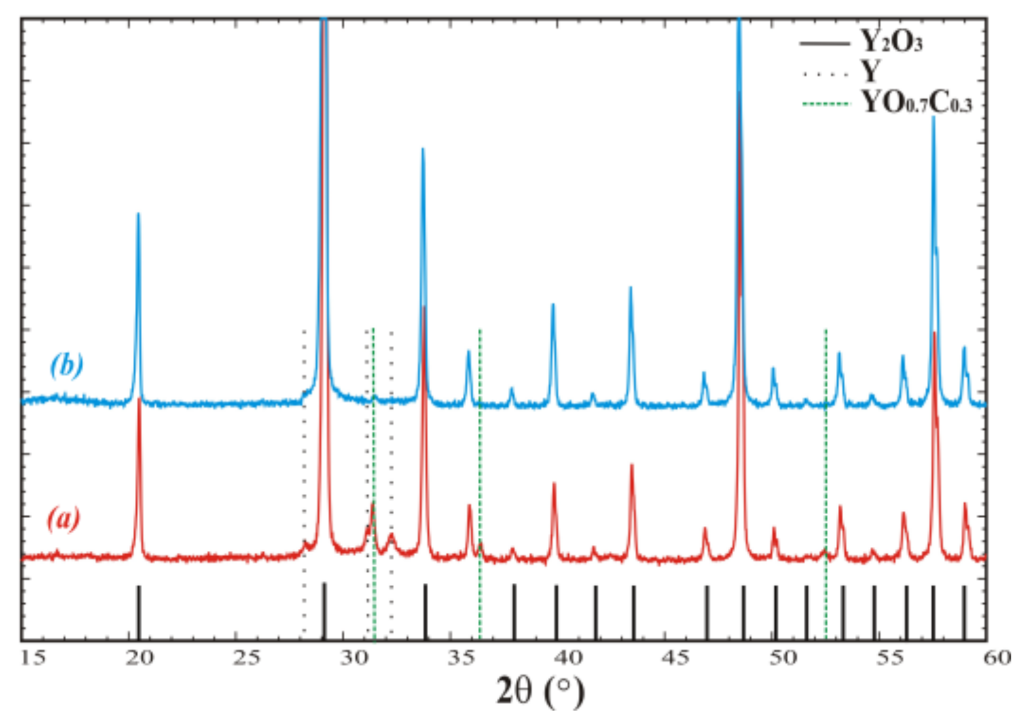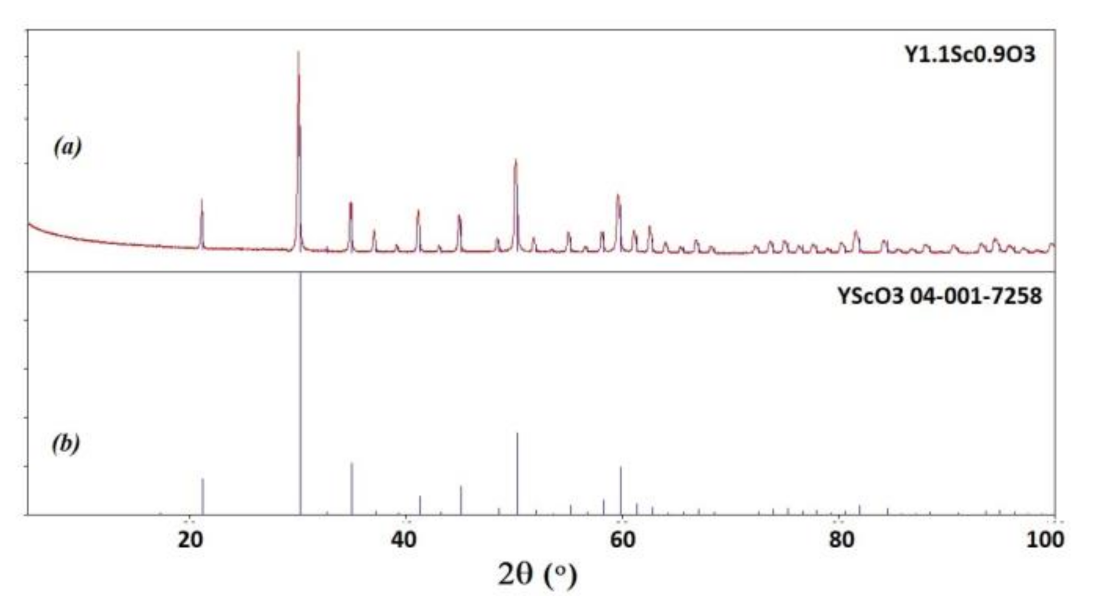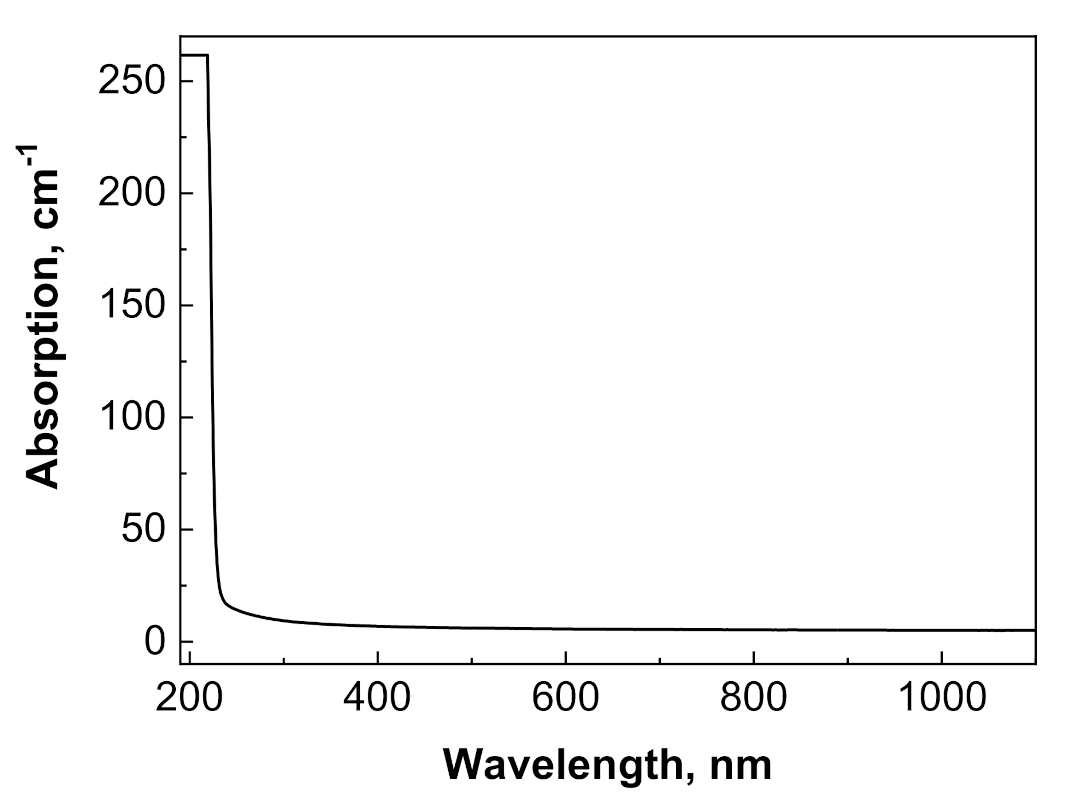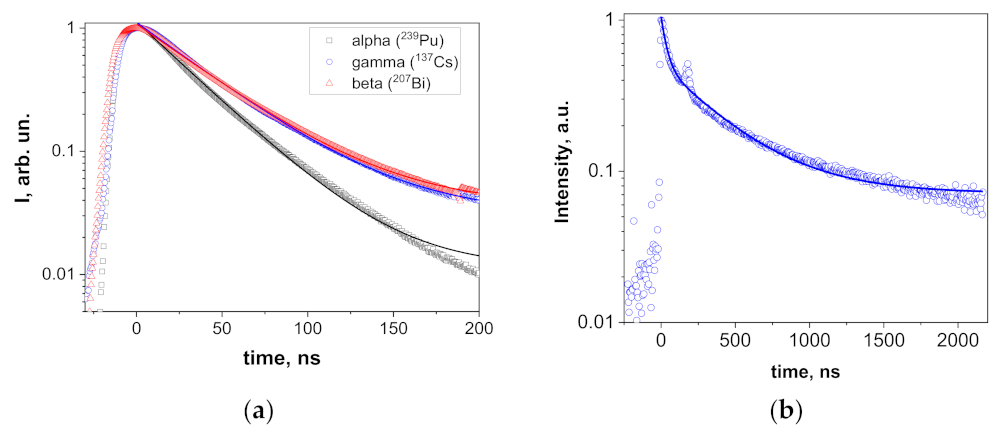Growth of Sesquioxide Crystals from Tungsten Crucibles by Vertical Gradient Freezing Method
Abstract
:1. Introduction
2. Materials and Methods
3. Results and Discussion
3.1. Preventing Melt from Carbidization
3.2. VFG Growth
3.3. Optical and Scintillation Characterization
4. Conclusions
Author Contributions
Funding
Data Availability Statement
Conflicts of Interest
References
- Futami, Y.; Yanagida, T.; Fujimoto, Y.; Pejchal, J.; Sugiyama, M.; Kurosawa, S.; Yokota, Y.; Ito, A.; Yoshikawa, A.; Goto, T. Optical and scintillation properties of Sc2O3, Y2O3 and Lu2O3 transparent ceramics synthesized by SPS method. Radiat. Meas. 2013, 55, 136–140. [Google Scholar] [CrossRef]
- Fukabori, A.; Chani, V.; Kamada, K.; Moretti FYoshikawa, A. Growth of Tm3+-doped Y2O3, Sc2O3, and Lu2O3 crystals by the micropulling down technique and their optical and scintillation characteristics. Cryst. Growth Des. 2011, 11, 2404–2411. [Google Scholar] [CrossRef]
- Thoř, T.; Rubešová, K.; Jakeš, V.; Cajzl, J.; Nádherný, L.; Mikolášová, D.; Kučerková, R.; Nikl, M. Lanthanide-doped Lu2O3 phosphors and scintillators with green-to-red emission. J. Lumin. 2019, 215, 116647. [Google Scholar] [CrossRef]
- Thoř, T.; Rubešová, K.; Jakeš, V.; Cajzl, J.; Nádherný, L.; Mikolášová, D.; Beitlerová, A.; Nikl, M. Europium-doped Lu2O3 phosphors prepared by a sol-gel method. IOP Conf. Ser. Mater. Sci. Eng. 2018, 465, 012009. [Google Scholar] [CrossRef]
- Pirri, A.; Toci, G.; Patrizi, B.; Vannini, M. An overview on Yb-Doped transparent polycrystalline sesquioxide laser ceramics. IEEE J. Sel. Top. Quantum Electron. 2018, 24, 1–8. [Google Scholar] [CrossRef]
- Liu, Z.; Toci, G.; Pirri, A.; Patrizi, B.; Feng, Y.; Chen, X.; Hu, D.; Feng, T.; Lexiang, W.; Matteo, V.; et al. Fabrication and Optical Property of Nd:Lu2O3 Transparent Ceramics for Solid-state Laser Applications. Inorg. Mater. 2020, 36, 210–216. [Google Scholar] [CrossRef]
- Hlavac, J. Melting temperatures of refractory oxides: Part I. Pure Appl. Chem. 1982, 54, 681–688. [Google Scholar] [CrossRef] [Green Version]
- Coutures, J.P.; Rand, M.H. Melting temperatures of refractory oxides-Part II: Lanthanoid sesquioxides. Pure Appl. Chem. 1989, 61, 1461–1482. [Google Scholar] [CrossRef]
- Zhang, J.; Chen, H.; Wang, J.; Wang, D.; Han, D.; Zhang, J.; Wang, S. Preparation of (Tb1−xLux)2O3 transparent ceramics by solid solution for magneto-optical application. J. Eur. Ceram. Soc. 2021, 41, 2818–2825. [Google Scholar] [CrossRef]
- Südmeyer, T.; Kränkel, C.; Baer, C.R.E.; Heckl, O.H.; Saraceno, C.J.; Golling, M.; Peters, R.; Petermann, K.; Huber, G.; Keller, U. High-power ultrafast thin disk laser oscillators and their potential for sub-100-femtosecond pulse generation. Appl. Phys. B 2009, 97, 281–295. [Google Scholar] [CrossRef]
- Kränkel, C. Rare-earth-doped sesquioxides for diode-pumped high-power lasers in the 1-, 2-, and 3-μm spectral range. IEEE J. Sel. Top. Quantum. Electron. 2014, 21, 250–262. [Google Scholar] [CrossRef]
- Boulesteix, R.; Epherre, R.; Noyau, S.; Vandenhende, M.; Maitre, A.; Sallé, C.; Alombert-Goget, G.; Guyot, Y.; Brenier, A. Highly transparent Nd: Lu2O3 ceramics obtained by coupling slip-casting and spark plasma sintering. Scr. Mater. 2014, 75, 54–57. [Google Scholar] [CrossRef]
- Kryzhanovska, O.S.; Baumer, V.N.; Parkhomenko, S.V.; Doroshenko, A.G.; Yavetskiy, R.P.; Balabanov, A.E.; Tolmachev, A.V.; Skorik, S.N.; Li, J.; Kuncser, A. Formation peculiarities and optical properties of highly-doped (Y0.86La0.09Yb0.05)2O3 transparent ceramics. Ceram. Int. 2019, 45, 16002–16007. [Google Scholar] [CrossRef]
- Kim, K.J.; Kamada, K.; Murakami, R.; Horiai, T.; Ishikawa, S.; Kochurikhin, V.V.; Yoshino, M.; Yamaji, A.; Shoji, Y.; Kurosawa, S.; et al. Growth of Lu2O3 and HfO2 Based High Melting Temperature Single Crystals by Indirect Heating Method Using Arc Plasma. Crystals 2020, 10, 619. [Google Scholar] [CrossRef]
- Zhang, N.; Yin, Y.; Zhang, J.; Wang, T.; Wang, S.; Yin, Y.; Fu, X.; Jia, Z.; Tao, X. Optimized growth of high length-to-diameter ratio Lu2O3 single crystal fibers by the LHPG method. CrystEngComm 2021, 23, 1657–1662. [Google Scholar] [CrossRef]
- Hou, W.; Zhao, H.; Li, N.; Xue, Y.; Shi, J.; Xu, X.; Xu, J. Growth and spectroscopic properties of Er: Lu2O3 crystal grown by floating zone method. Mater. Res. Express 2019, 6, 066203. [Google Scholar] [CrossRef]
- Guzik, M.; Pejchal, J.; Yoshikawa, A.; Ito, A.; Goto, T.; Siczek, M.; Lis, T.; Boulon, G. Structural investigations of Lu2O3 as single crystal and polycrystalline transparent ceramic. Cryst. Growth Des. 2014, 14, 3327–3334. [Google Scholar] [CrossRef]
- Yin, Y.; Wang, G.; Jia, Z.; Mu, W.; Fu, X.; Zhang, J.; Tao, X. Controllable and directional growth of Er: Lu2O3 single crystals by the edge-defined film-fed technique. CrystEngComm 2020, 22, 6569–6573. [Google Scholar] [CrossRef]
- Peters, R.; Kränkel, C.; Petermann, K.; Huber, G. Crystal growth by the heat exchanger method, spectroscopic characterization and laser operation of high-purity Yb:Lu2O3. J. Cryst. Growth 2008, 310, 1934–1938. [Google Scholar] [CrossRef]
- Hu, K.; Zheng, L.; Zhang, H. Control of interface shape during high melting sesquioxide crystal growth by HEM technique. J. Cryst. Growth 2018, 483, 175–182. [Google Scholar] [CrossRef]
- Kränkel, C.; Uvarova, A.; Haurat, É.; Hülshoff, L.; Brützam, M.; Guguschev, C.; Kalusniak, S.; Klimm, D. Czochralski growth of mixed cubic sesquioxide crystals in the ternary system Lu2O3–Sc2O3–Y2O3. Acta. Crystallogr. B. Struct. Sci. Cryst. Eng. Mater. 2021, 77, 550–558. [Google Scholar] [CrossRef]
- Suzuki, A.; Kalusniak, S.; Tanaka, H.; Brützam, M.; Ganschow, S.; Tokurakawa, M.; Kränkel, C. Spectroscopy and 2.1 µm laser operation of Czochralski-grown Tm3+:YScO3 crystals. Opt. Express 2022, 30, 42762–42771. [Google Scholar] [CrossRef] [PubMed]
- Dong, J.; Zhao, H.; Cao, X.; Wang, W.; Xu, X.; Wu, F.; Luo, P.; Wang, Q.; Xue, Y.; Xu, J. Crystal growth and spectroscopic analysis of Ho, Pr:Sc2O3 crystal for 2.9 μm mid-IR laser. Opt. Mater. Express 2021, 11, 2539–2546. [Google Scholar] [CrossRef]
- Sidletskiy, O.; Gerasymov, I.; Boyaryntseva, Y.; Arhipov, P.; Tkachenko, S.; Zelenskaya, O.; Bryleva, K.; Belikov, K.; Lebbou, K.; Dujardin, C.; et al. Impact of Carbon Co-Doping on the Optical and Scintillation Properties of a YAG: Ce Scintillator. Cryst. Growth Des. 2021, 21, 3063–3070. [Google Scholar] [CrossRef]
- Tkachenko, S.; Arhipov, P.; Gerasymov, I.; Galenin, E.; Shaposhnyk, A.; Hryshyna, O.; Mateychenko, P.; Boyaryntseva, Y.; Zelenskaya, O.; Lebbou, K.; et al. The crystal growth of ortho-and pyrosilicates from W and Mo crucibles. CrystEngComm 2021, 23, 360–367. [Google Scholar] [CrossRef]
- Gerasymov, I.; Hubenko, K.; Viagin, O.; Boyarintseva, Y.; Shaposhnyk, A.; Baumer, V.; Gorbacheva, T.; Zelenskaya, O.; Galenin, E.; Kurtsev, D.; et al. Characterization of LaGPS:Ce scintillation crystals obtained under a reducing atmosphere. CrystEngComm 2022, 24, 7066–7072. [Google Scholar] [CrossRef]
- Scintillation Properties—Lawrence Berkeley National Laboratory. Available online: Scintillator.lbl.gov (accessed on 13 March 2023).
- Sidletskiy, O.; Arhipov, P.; Tkachenko, S.; Zelenskaya, O.; Vasyukov, S.; Moretti, F.; Dujardin, C. Drastic Scintillation Yield Enhancement of YAG:Ce with Carbon Doping. Phys. Status Solidi A 2018, 215, 1800122. [Google Scholar] [CrossRef]
- Holleman, A.F.; Wiberg, E.; Wiberg, N. Inorganic Chemistry; Academic Press: Cambridge, MA, USA, 2001. [Google Scholar]
- Nizhankovsky, S.; Krivonosov, E.; Baranov, V.; Budnikov, A.; Kanishchev, V.; Grin, L.; Adonkin, G. Optical homogeneity of Ti:sapphire crystals grown by horizontal directional solidification. Inorg. Mater. 2012, 48, 1111–1114. [Google Scholar] [CrossRef]
- Adachi, G.; Imanaka, N. The binary rare earth oxides. Chem. Rev. 1998, 98, 1479–1514. [Google Scholar] [CrossRef]
- Badehian, H.A.; Salehi, H.; Ghoohestani, M. First-principles study of elastic, structural, electronic, thermodynamical, and optical properties of Yttria (Y2O3) ceramic in cubic phase. J. Am. Ceram. Soc. 2013, 96, 1832–1840. [Google Scholar] [CrossRef]
- Lushchik, A.; Kirm, M.; Lushchik Ch Martinson, I.; Zimmerer, G. Luminescence of free and self-trapped excitons in wide-gap oxides. J. Lumin. 2000, 87–89, 232–234. [Google Scholar] [CrossRef]
- Zheng, J.X.; Ceder, G.; Maxisch, T.; Chim, W.K.; Choi, W.K. Native point defects in yttria and relevance to its use as a high-dielectric-constant gate oxide material: First-principles study. Phys. Rev. B 2006, 73, 104101. [Google Scholar] [CrossRef] [Green Version]
- Nambu, K.; Hayasaka, H.; Yamamoto, T.; Yoshida, H. Photoluminescence properties of undoped and Si4+-doped polycrystalline Y2O3 phosphors prepared by flash-sintering. Appl. Phys. Express 2019, 12, 075504. [Google Scholar] [CrossRef]
- Huang, H.; Sun, X.; Wang, S.; Liu, Y.; Li, X.; Liu, J.; Kang, Z.; Lee, S.-T. Strong red emission of pure Y2O3 nanoparticles from oxygen related defects. Dalton Trans. 2011, 40, 11362–11366. [Google Scholar] [CrossRef]
- Zorenko, Y.; Zorenko, T.; Voznyak, T.; Mandowski, A.; Xia, Q.; Batentschuk, M.; Fridrich, J. Luminescence of F+ and F centers in Al2O3-Y2O3 oxide compounds. IOP Conf. Ser. Mater. Sci. Eng. 2010, 15, 012060. [Google Scholar] [CrossRef]
- Kumar, Y.; Pal, M.; Herrera, M.; Mathew, X. Effect of Eu ion incorporation on the emission behavior of Y2O3 nanophosphors: A detailed study of structural and optical properties. Opt. Mater. 2016, 60, 159–168. [Google Scholar] [CrossRef]
- Witkiewicz-Lukaszek, S.; Gorbenko, V.; Zorenko, T.; Syrotych, Y.; Mares, J.A.; Nikl, M.; Sidletskiy, O.; Bilski, P.; Yoshikawa, A.; Zorenko, Y. Composite Detectors Based on Single-Crystalline Films and Single Crystals of Garnet Compounds. Materials 2022, 15, 1249. [Google Scholar] [CrossRef]
- Sidletskiy, O.; Gorbenko, V.; Zorenko, T.; Syrotych, Y.; Witkiwicz-Łukaszek, S.; Mares, J.A.; Kucerkova, R.; Nikl, M.; Gerasymov, I.; Kurtsev, D.; et al. Composition Engineering of (Lu,Gd,Tb)3(Al,Ga)5O12:Ce Film/Gd3(Al,Ga)5O12:Ce Substrate Scintillators. Crystals 2022, 12, 1366. [Google Scholar] [CrossRef]







Disclaimer/Publisher’s Note: The statements, opinions and data contained in all publications are solely those of the individual author(s) and contributor(s) and not of MDPI and/or the editor(s). MDPI and/or the editor(s) disclaim responsibility for any injury to people or property resulting from any ideas, methods, instructions or products referred to in the content. |
© 2023 by the authors. Licensee MDPI, Basel, Switzerland. This article is an open access article distributed under the terms and conditions of the Creative Commons Attribution (CC BY) license (https://creativecommons.org/licenses/by/4.0/).
Share and Cite
Galenin, E.; Galenina, V.; Gerasymov, I.; Kurtsev, D.; Tkachenko, S.; Arhipov, P.; Sadivnycha, S.; Alekseev, V.; Shaposhnyk, A.; Boiaryntseva, I.; et al. Growth of Sesquioxide Crystals from Tungsten Crucibles by Vertical Gradient Freezing Method. Crystals 2023, 13, 591. https://doi.org/10.3390/cryst13040591
Galenin E, Galenina V, Gerasymov I, Kurtsev D, Tkachenko S, Arhipov P, Sadivnycha S, Alekseev V, Shaposhnyk A, Boiaryntseva I, et al. Growth of Sesquioxide Crystals from Tungsten Crucibles by Vertical Gradient Freezing Method. Crystals. 2023; 13(4):591. https://doi.org/10.3390/cryst13040591
Chicago/Turabian StyleGalenin, Evgeny, Viktoriia Galenina, Iaroslav Gerasymov, Daniil Kurtsev, Serhii Tkachenko, Pavlo Arhipov, Sofiia Sadivnycha, Vadim Alekseev, Anna Shaposhnyk, Ianina Boiaryntseva, and et al. 2023. "Growth of Sesquioxide Crystals from Tungsten Crucibles by Vertical Gradient Freezing Method" Crystals 13, no. 4: 591. https://doi.org/10.3390/cryst13040591
APA StyleGalenin, E., Galenina, V., Gerasymov, I., Kurtsev, D., Tkachenko, S., Arhipov, P., Sadivnycha, S., Alekseev, V., Shaposhnyk, A., Boiaryntseva, I., Niestierkina, V., Witkiewicz-Łukaszek, S., Zorenko, Y., & Sidletskiy, O. (2023). Growth of Sesquioxide Crystals from Tungsten Crucibles by Vertical Gradient Freezing Method. Crystals, 13(4), 591. https://doi.org/10.3390/cryst13040591






